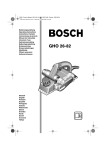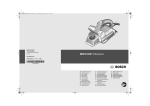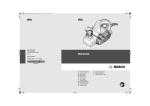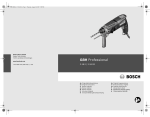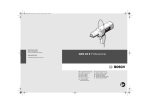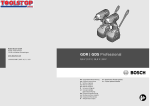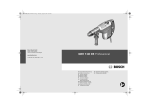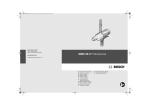Download Bosch GHO 26-82 Operating instructions
Transcript
OBJ_DOKU-7469-001.fm Page 1 Monday, September 17, 2007 10:32 AM Robert Bosch GmbH Power Tools Division 70745 Leinfelden-Echterdingen www.bosch-pt.com GHO 26-82 Professional 1 609 929 M03 (2007.09) O / 105 de en fr es pt it nl Originalbetriebsanleitung Original instructions Notice originale Manual original Manual original Istruzioni originali Oorspronkelijke gebruiksaanwijzing da Original brugsanvisning sv Bruksanvisning i original no Original driftsinstruks fi Alkuperäiset ohjeet el Πρωτότυπο οδηγιών χρήσης tr Orijinal işletme talimat OBJ_BUCH-446-001.book Page 3 Monday, September 17, 2007 10:34 AM 3| 4 5 3 2 1 9 8 3 7 6 10 GHO 26-82 Professional 1 609 929 M03 | (17.9.07) Bosch Power Tools OBJ_BUCH-446-001.book Page 4 Monday, September 17, 2007 10:34 AM 4| A B 9 15 15 14 9 11 12 13 C D 17 ø 35 mm 16 18 3 E 24 19 25 21 20 19 20 23 21 22 1 609 929 M03 | (17.9.07) Bosch Power Tools OBJ_BUCH-446-001.book Page 5 Monday, September 17, 2007 10:34 AM 5| F G 9 9 mm max 26 82 ma mm x H I 10 45° 7 27 6 K 29 27 28 1 609 929 M03 | (17.9.07) Bosch Power Tools OBJ_BUCH-446-001.book Page 14 Monday, September 17, 2007 10:34 AM 14 | English General Power Tool Safety Warnings en WARNING Read all safety warnings and all instructions. Failure to follow the warnings and instructions may result in electric shock, fire and/or serious injury. Save all warnings and instructions for future reference. The term “power tool” in the warnings refers to your mains-operated (corded) power tool or battery-operated (cordless) power tool. 1) Work area safety a) Keep work area clean and well lit. Cluttered or dark areas invite accidents. b) Do not operate power tools in explosive atmospheres, such as in the presence of flammable liquids, gases or dust. Power tools create sparks which may ignite the dust or fumes. c) Keep children and bystanders away while operating a power tool. Distractions can cause you to lose control. 2) Electrical safety a) Power tool plugs must match the outlet. Never modify the plug in any way. Do not use any adapter plugs with earthed (grounded) power tools. Unmodified plugs and matching outlets will reduce risk of electric shock. b) Avoid body contact with earthed or grounded surfaces, such as pipes, radiators, ranges and refrigerators. There is an increased risk of electric shock if your body is earthed or grounded. c) Do not expose power tools to rain or wet conditions. Water entering a power tool will increase the risk of electric shock. d) Do not abuse the cord. Never use the cord for carrying, pulling or unplugging the power tool. Keep cord away from heat, oil, sharp edges and moving parts. Damaged or entangled cords increase the risk of electric shock. 1 609 929 M03 | (17.9.07) e) When operating a power tool outdoors, use an extension cord suitable for outdoor use. Use of a cord suitable for outdoor use reduces the risk of electric shock. f) If operating a power tool in a damp location is unavoidable, use a residual current device (RCD) protected supply. Use of an RCD reduces the risk of electric shock. 3) Personal safety a) Stay alert, watch what you are doing and use common sense when operating a power tool. Do not use a power tool while you are tired or under the influence of drugs, alcohol or medication. A moment of inattention while operating power tools may result in serious personal injury. b) Use personal protective equipment. Always wear eye protection. Protective equipment such as dust mask, non-skid safety shoes, hard hat, or hearing protection used for appropriate conditions will reduce personal injuries. c) Prevent unintentional starting. Ensure the switch is in the off-position before connecting to power source and/or battery pack, picking up or carrying the tool. Carrying power tools with your finger on the switch or energising power tools that have the switch on invites accidents. d) Remove any adjusting key or wrench before turning the power tool on. A wrench or a key left attached to a rotating part of the power tool may result in personal injury. e) Do not overreach. Keep proper footing and balance at all times. This enables better control of the power tool in unexpected situations. f) Dress properly. Do not wear loose clothing or jewellery. Keep your hair, clothing and gloves away from moving parts. Loose clothes, jewellery or long hair can be caught in moving parts. Bosch Power Tools OBJ_BUCH-446-001.book Page 15 Monday, September 17, 2007 10:34 AM English | 15 g) If devices are provided for the connection of dust extraction and collection facilities, ensure these are connected and properly used. Use of dust collection can reduce dust-related hazards. 5) Service a) Have your power tool serviced by a qualified repair person using only identical replacement parts. This will ensure that the safety of the power tool is maintained. 4) Power tool use and care a) Do not force the power tool. Use the correct power tool for your application. The correct power tool will do the job better and safer at the rate for which it was designed. b) Do not use the power tool if the switch does not turn it on and off. Any power tool that cannot be controlled with the switch is dangerous and must be repaired. c) Disconnect the plug from the power source and/or the battery pack from the power tool before making any adjustments, changing accessories, or storing power tools. Such preventive safety measures reduce the risk of starting the power tool accidentally. d) Store idle power tools out of the reach of children and do not allow persons unfamiliar with the power tool or these instructions to operate the power tool. Power tools are dangerous in the hands of untrained users. e) Maintain power tools. Check for misalignment or binding of moving parts, breakage of parts and any other condition that may affect the power tool’s operation. If damaged, have the power tool repaired before use. Many accidents are caused by poorly maintained power tools. f) Keep cutting tools sharp and clean. Properly maintained cutting tools with sharp cutting edges are less likely to bind and are easier to control. g) Use the power tool, accessories and tool bits etc. in accordance with these instructions, taking into account the working conditions and the work to be performed. Use of the power tool for operations different from those intended could result in a hazardous situation. Bosch Power Tools Machine-specific Safety Warnings f Wait for the cutter to stop before setting the tool down. An exposed cutter may engage the surface leading to possible loss of control and serious injury. f Do not reach into the saw dust ejector with your hands. They could be injured by rotating parts. f Apply the machine to the workpiece only when switched on. Otherwise there is danger of kickback when the cutting tool jams in the workpiece. f When working, always hold the planer in such a manner that the planer base plate faces flat on the workpiece. Otherwise the planer can become wedged and lead to injuries. f Never plane over metal objects, nails or screws. The planer blade and the blade shaft can become damaged and lead to increased vibrations. f Secure the workpiece. A workpiece clamped with clamping devices or in a vice is held more secure than by hand. f Do not work materials containing asbestos. Asbestos is considered carcinogenic. f Take protective measures when dust can develop during working that is harmful to one’s health, combustible or explosive. Example: Some dusts are regarded as carcinogenic. Wear a dust mask and work with dust/chip extraction when connectable. f Never use the machine with a damaged cable. Do not touch the damaged cable and pull the mains plug when the cable is damaged while working. Damaged cables increase the risk of an electric shock. 1 609 929 M03 | (17.9.07) OBJ_BUCH-446-001.book Page 16 Monday, September 17, 2007 10:34 AM 16 | English Functional Description Read all safety warnings and all instructions. Failure to follow the warnings and instructions may result in electric shock, fire and/or serious injury. While reading the operating instructions, unfold the graphics page for the machine and leave it open. Intended Use The machine is intended for planing of firmly supported wooden materials, such as beams and boards. It is also suitable for beveling edges and rebating. Product Features The numbering of the product features refers to the illustration of the machine on the graphics page. 24 Fastening bolt for rebating depth stop 25 Rebating depth stop* 26 Park rest 27 Drive belt 28 Large pulley 29 Small pulley *The accessories illustrated or described are not included as standard delivery. Technical Data Planer GHO 26-82 Professional Article number 0 601 594 1.. 0 601 594 3.. Rated power input W 710 Output power W 400 No-load speed rpm 16500 Planing depth mm 0 – 2.6 1 Planing depth scale Rebating depth mm 0–9 2 Depth adjustment knob Planing width, max. mm 82 3 Chip ejector (alternatively right/left) 4 Lock-off button for On/Off switch Weight according to EPTA-Procedure 01/2003 kg 2.6 5 On/Off switch Protection class 6 Belt cover 7 Screw for belt cover 8 Chip ejection selector lever 9 Planer base plate 10 V-grooves 11 Blade drum 12 Clamping element for blade 13 Fastening screw for planer blade 14 Carbide blade (TC) 15 Allen key 16 Extraction hose (Ø 35 mm)* 17 Chip/dust bag* 18 Parallel guide 19 Scale for rebating width 20 Locking nut for adjustment of rebating width 21 Fastening bolt for parallel and beveling guide 22 Angle stop* / II The values given are valid for nominal voltages [U] of 230/240 V. For lower voltage and models for specific countries, these values can vary. Please observe the article number on the type plate of your machine. The trade names of the individual machines may vary. Noise/Vibration Information Measured values determined according to EN 60745. Typically the A-weighted noise levels of the product are: Sound pressure level 84 dB(A); Sound power level 95 dB(A). Uncertainty K =3 dB. Wear hearing protection! Vibration total values (triax vector sum) determined according to EN 60745: Vibration emission value ah =7.8 m/s2, Uncertainty K =1.5 m/s2. 23 Locking nut for angle adjustment 1 609 929 M03 | (17.9.07) Bosch Power Tools OBJ_BUCH-446-001.book Page 17 Monday, September 17, 2007 10:34 AM English | 17 The vibration emission level given in this information sheet has been measured in accordance with a standardised test given in EN 60745 and may be used to compare one tool with another. It may be used for a preliminary assessment of exposure. The declared vibration emission level represents the main applications of the tool. However if the tool is used for different applications, with different accessories or poorly maintained, the vibration emission may differ. This may significantly increase the exposure level over the total working period. An estimation of the level of exposure to vibration should also take into account the times when the tool is switched off or when it is running but not actually doing the job. This may significantly reduce the exposure level over the total working period. Identify additional safety measures to protect the operator from the effects of vibration such as: maintain the tool and the accessories, keep the hands warm, organisation of work patterns. Declaration of Conformity We declare under our sole responsibility that the product described under “Technical Data” is in conformity with the following standards or standardization documents: EN 60745 according to the provisions of the directives 2004/108/EC, 98/37/EC (until Dec. 28, 2009), 2006/42/EC (from Dec. 29, 2009 on). Technical file at: Robert Bosch GmbH, PT/ESC, D-70745 Leinfelden-Echterdingen Dr. Egbert Schneider Senior Vice President Engineering Dr. Eckerhard Strötgen Head of Product Certification 01.08.2007, Robert Bosch GmbH, Power Tools Division D-70745 Leinfelden-Echterdingen Assembly f Before any work on the machine itself, pull the mains plug. Bosch Power Tools Changing the Tool f Be cautious when replacing the planer blades. Do not grasp the planer blades by the cutting edges. Possible danger of injury due to the sharp cutting edges of the planer blades. Use only original Bosch carbide blades (TC). The carbide blade (TC) has 2 cutting edges and can be reversed. When both cutting edges are dull, the planer blade 14 must be replaced. The carbide blade (TC) may not be resharpened. Disassembling the Planer Blade(s) (see figure A) To reverse or replace the planer blade 14, rotate the blade drum 11 until it is parallel to the planer base plate 9. n Loosen the two fastening screws 13 with the Allen key 15 by approx. 1 – 2 turns. o If necessary, loosen the clamping element 12 by giving it a light blow with a suitable tool (e.g. a wooden wedge). p Push the planer blade 14 sidewards out of the blade drum 11 with a piece of wood. Assembling the Planer Blade(s) (see figure B) The guide groove of the planer blade always ensures continuous height adjustment when replacing or reversing it. If required, clean the blade seat in the clamping element 12 and the planer blade 14. When assembling the planer blade, ensure that it is seated properly in the blade holder of the clamping element 12. The planer blade must be assembled and aligned centred to the planer base plate 9 Afterwards tighten the 2 fastening screws 13 with the Allen key 15. Note: Before restarting, check if the fastening screws 13 are tightened well. Rotate the blade drum 11 by hand and ensure that the planer blade does not graze. Dust/Chip Extraction Clean the chip ejector 3 regularly. Use a suitable tool (e.g., a piece of wood, compressed air, etc.) to clean a clogged chip ejector. 1 609 929 M03 | (17.9.07) OBJ_BUCH-446-001.book Page 18 Monday, September 17, 2007 10:34 AM 18 | English f Do not reach into the saw dust ejector with your hands. They could be injured by rotating parts. To ensure optimum extraction of dust/chips, always work with external dust extraction or a chip/dust bag. External Dust Extraction (see figure C) An extraction hose (Ø 35 mm) 16 (accessory), can be attached on either side of the chip ejector. Connect the vacuum hose 16 to a vacuum cleaner (accessory). An overview for connecting to various vacuum cleaners can be found at the end of this manual. The vacuum cleaner must be suitable for the material being worked. When vacuuming dry dust that is especially detrimental to health or carcinogenic, use a special vacuum cleaner. Integrated Dust Extraction (see figure C) A chip/dust bag (accessory) 17 can be used for smaller jobs. Insert the sleeve of the chip/dust bag firmly into the chip ejector 3. Empty the chip/dust bag 17 at regulary intervals to maintain optimum dust collection. Park Rest (see figure G) The park rest 26 allows the machine to be set down directly after operation, without danger of damaging the working surface or the planer blade. While planing, the park rest 26 is tilted upwards thus enabling full contact of the rear part of the planer base plate 9. Starting Operation f Observe correct mains voltage! The voltage of the power source must agree with the voltage specified on the nameplate of the machine. Power tools marked with 230 V can also be operated with 220 V. Switching On and Off To start the machine, first push the lock-off button for the On/Off switch 4 and then press the On/Off switch 5 and keep it pressed. To switch off the machine, release the On/Off switch 5. Note: For safety reasons, the On/Off switch 5 cannot be locked; it must remain pressed during the entire operation. Working Advice Choice of Chip Ejector Side Planing (see figure G) With the selector lever 8, the chip ejector 3 can be switched to right or left. Always press the selector lever 8 until it engages in the end position. The selected ejection direction is indicated by an arrow symbol on the selector lever 8. Set the required planing depth and place the front part of the planer base plate 9 against the workpiece. Operation Switch the machine on and guide the machine with even feed over the surface to be planed. Operating Modes Adjusting the Planing Depth With the adjustment knob 2, the planing depth can be adjusted variably from 0–2.6 mm using the planing depth scale 1 (scale graduation = 0.1 mm). 1 609 929 M03 | (17.9.07) f Apply the machine to the workpiece only when switched on. Otherwise there is danger of kickback when the cutting tool jams in the workpiece. To achieve high-grade surfaces, work only with low feed and apply pressure on the centre of the planer base plate. When machining hard materials (e.g. hardwood) as well as when utilising the maximum planer width, set only low planing depths and reduce planer feed, as required. Excessive feed reduces the surface quality and can lead to rapid clogging of the chip ejector. Bosch Power Tools OBJ_BUCH-446-001.book Page 19 Monday, September 17, 2007 10:34 AM English | 19 Only sharp blades achieve good cutting capacity and give the machine longer life. The integrated park rest 26 also allows for continued planing at any given location on the workpiece after an interruption: – With the park rest folded down, place the machine on the location of the workpiece where the planing is to be continued. – Switch on the machine. – Apply the supporting pressure onto the front part of the planer base plate and slowly push the machine forward (n). This tilts the park rest upward (o) so that the rear part of the planer base plate faces on the workpiece again. – Guide the machine over the surface to be planed (p) with even feed. Beveling Edges (see figure H) The V-grooves in the front planer base plate allow quick and easy beveling of workpiece edges. Depending on required bevel width, use the corresponding V-groove. For this, place the planer with the V-groove onto the edge of the workpiece and guide it along the edge. Groove to be used none small medium large Dimension a (mm) 0–4 2–6 4–9 6 – 10 Planing with Parallel/Beveling Guide (see figures D–F) Mount the parallel guide 18 or beveling guide 22 to the machine using the corresponding fastening bolt 21. Depending on the application, mount the rebating depth stop 25 with fastening bolt 24 to the machine. Carry out the planing procedure several times until the requested rebating depth is reached. Guide the planer applying sideward supporting pressure. Beveling with the Beveling Guide When beveling rebates and surfaces, adjust the required slope angle with the angle adjustment 23. Maintenance and Service Maintenance and Cleaning f Before any work on the machine itself, pull the mains plug. f For safe and proper working, always keep the machine and ventilation slots clean. Ensure easy operation of the park rest 26 and clean it regularly. When the carbon brushes wear below acceptable service tolerances, the machine will automatically cut out. The machine must be sent to customer service for maintenance (for address, see the “After-sales service and customer assistance” section). If the machine should fail despite the care taken in manufacturing and testing procedures, repair should be carried out by an after-sales service centre for Bosch power tools. In all correspondence and spare parts order, please always include the 10-digit article number given on the type plate of the machine. Loosen the locking nut 20 and adjust the requested rebating width on the scale 19. Tighten the locking nut 20 again. Adjust the requested rebating depth accordingly with the rebating depth stop 25. Bosch Power Tools 1 609 929 M03 | (17.9.07) OBJ_BUCH-446-001.book Page 104 Monday, September 17, 2007 10:34 AM 104 | 1 608 132 006 1x: 2 608 635 376 2x: 2 608 635 350 2 607 000 102 2 605 411 035 2 607 001 077 (45°) Ø 35 mm 3 m 2 609 390 392 5 m 2 609 390 393 1 609 929 M03 | (17.9.07) 2 605 438 532 GAS 25 GAS 50 GAS 50 M Bosch Power Tools











